![]()
![]()
![]()
Use LEFT and RIGHT arrow keys to navigate between flashcards;
Use UP and DOWN arrow keys to flip the card;
H to show hint;
A reads text to speech;
26 Cards in this Set
- Front
- Back
|
In purine biosynthesis, the common intermediate before branching to make AMP and GMP is _______.
|
IMP
Inosinate! |
|
|
True or False:
In pyrimidine biosynthesis, UTP is a precursor to CTP. |
True.
|
|
|
Ribonucleotide reductase reduces the 2' hydroxy to a 2' _____.
|
hydrogen.
Ribonucleotide reductase is involved in the biosynthesis of deoxyribose. |
|
|
UDP that is acted upon with a ribonucleotide reductase yields...
|
dUDP which is then kinased up to dUTP but quickly dUTPased to dUMP which is methylated. Sucessive reactions bring it to dTTP which is then used for DNA replication.
|
|
|
Both 5-Flurouracil and methotrexate do what?
|

both reduce dTMP synthesis and thus reduce the pool of dTTP and diminish the capacity of the cell to replicate DNA.
|
|
|
The drug 5-fluorouracil reduces dTMP synthesis (thereby reducing the pool of dTTP and the capacity of the cell to replicate DNA by blocking) by blocking:
a) dihydrofolate reductase b) thymidylate synthase c) guanylate kinase d) adenylate kinase |
b) thymidylate synthase
|
|
|
The drug Methotrexate reduces dTMP synthesis (thereby reducing the pool of dTTP and the capacity of the cell to replicate DNA by blocking) by blocking:
a) dihydrofolate reductase b) thymidylate synthase c) guanylate kinase d) adenylate kinase |
a) dihydrofolate reductase
|
|
|
Degradation of purines GMP and AMP are degraded to ____ and ____ respectively then ____ and ____ respectively then ____ and ____ which undergoes _______ to uric acid.
|
GMP -> guanosine -> guanine -> xanthine -> uric acid
AMP -> adenosine -> inosine -> hypoxanthine -> uric acid |
|
|
_____________ converts NDP to dNDP.
a) adenosine deaminase (ADA) b) Purine nucleoside phosphorylase (PNP) (c) Thymidylate synthase (d) Ribonucleotide reductase (e) Xanthine oxidase |
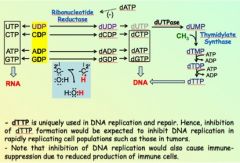
(d) Ribonucleotide reductase
|
|
|
__________ converts dUMP to dTMP. 5-fluorouracil and MTX inhibit these enzymes, respectively.
a) adenosine deaminase (ADA) b) Purine nucleoside phosphorylase (PNP) (c) Thymidylate synthase (d) Ribonycleotide reductase (e) Xanthine oxidase (f) Dihydrofolate reductase |
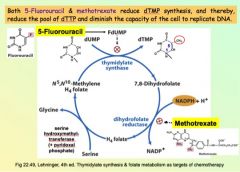
Thymidylate synthase and dihydrofolate reductase
|
|
|
_____ converts adenosine to inosine which is ultimately degraded to uric acid.
a) adenosine deaminase (ADA) b) Purine nucleoside phosphorylase (PNP) (c) Thymidylate synthase (d) Ribonycleotide reductase (e) Xanthine oxidase (f) Dihydrofolate reductase |

(a) adenosine deaminase (ADA)
|
|
|
Converts inosine to hypoxanthine, guanosine to guanine, which ultimately are degraded to uric acid.
a) adenosine deaminase (ADA) b) Purine nucleoside phosphorylase (PNP) (c) Thymidylate synthase (d) Ribonycleotide reductase (e) Xanthine oxidase (f) Dihydrofolate reductase |
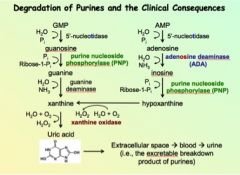
(b) Purine nucleoside phosphorylase (PNP)
|
|
|
_________ forms xanthine and uric acid. Allopurinol is an inhibitor.
a) adenosine deaminase (ADA) b) Purine nucleoside phosphorylase (PNP) (c) Thymidylate synthase (d) Ribonucleotide reductase (e) Xanthine oxidase |
(e) Xanthine oxidase
|
|
|
Purine bases are salvaged by reattachment of the _____ to ____ by: _______ and ______.
|
reattachment of the base to PRPP by APRT and HGPRT.
The nucleotide product then re-enters the nucleotide pools, reducing the pressure towards uric acid formation. |
|
|
True or False: Mammalian cells do not appear to possess as efficient a means of salvaging free purines bases as they do free pyrimidine bases.
|
FALSE. Mammalian cells don't have an efficient/good way of salvaging free PYRIMIDINES but do have a way for purines.
For pyrimidines, there are nucleoside kinases that can form pyrimidine nucleotides UMP, CMP, TMP. Only microorganisms have a pathway for free pyrimidine bases to be salvaged. |
|
|
_____ is uniquely used in DNA replication and repair. Thus, its inhibiting this formation could be expected to inhibit DNA replication in rapidly replicating cell populations such as those in tumors and/or also cause immune-suppression due to reduced production of immune cells.
|
dTTP
|
|
|
What enzyme turns NDP into dNDP?
(ie. UDP to dUDP, CDP to dCDP, etc.) |
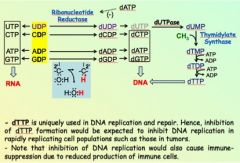
ribonucleotide reductase
|
|
|
After UDP becomes dUDP via ribuncleotide reductase, then kinased up to dUTP, dUTP is quickly acted upon by which enzyme, yielding _______ which is then _____ to produce ______ which is eventually phosphrylated up to _____.
|
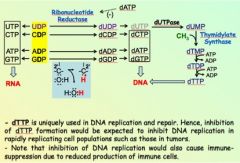
dUTPase ; yielding dUMP which is then methylated to dTMP which is eventually phosphorylated up to dTTP.
|
|
|
In the degradation of purines, GMP and AMP eventually both share a common intermediate which is broken down by ______ to uric acid. Name the intermediate.
|
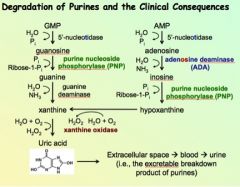
xanthine ----xanthine oxidase---> uric acid
|
|
|
What is a strong inhibitor for ribonucleotide reductase?
|
ribonucleotide reductase, which converts NDP to dNDP is strongly inhibited by dATP.
|
|
|
ADA, or Adenosine deaminase converts ______ into ______ which is ultimately converted/degraded to __________. This deficiency would lead to reduced degradation and increased levels of ________.
|
Adenosine deaminse, ADA, converts adenosine to inosine which is ultimately degraded into uric acid. This deficiency would lead to reduced degradation and increased levels of dATP, which is a strong inhibitor to ribonucleotide reductase.
|
|
|
Purine nucleoside phosphorylase (PNP) converts _____ to _____ and _____ to _____ which are ultimately degraded to __________. This deficiency affects T-cells only and causes recurrent infections and neural developmental delay.
|
inosine to hypoxanthine, and guanosine to guanine
|
|
|
Xanithine oxidase turns ________ to _____ and ______ to ________. Xanthine oxidase's inhibitor is __________.
|
Xantithine oxidase turns hypoxanthine to xanthine and then xanthine to uric acid. Xanthine oxidase is inhibited by allopurinol.
|
|
|
Free purine bases are salvaged by reattachment of the base to PRPP by what two enzymes for each respective purine?
|
for adenine: APRT
for hypoxanthine/guanine: HGPRT the nucleotide product then reenters the nucleotide pools, reducing the pressure toward uric acid formation and the potential for gouty deposits. |
|
|
What is the cause of Lesch-Nyhan Syndrome that include symptoms of mental retardation along with a propensity toward self-mutilation?
|
Caused by genetic deficits of salvage enzyme HGPRT resulting in excess uric acid production causing gout-like tissue damage in the brain.
|
|
|
Adenosine deaminase (ADA) results in varying degrees of immunodeficiency. Why?
|
ADA deficiency causes accumulation of adenosine, deoxyadenosine and dATP. Remember, dATP is a strong inhibitor for ribonucleotide reductase, thereby reducing dNTP needed for normal DNA synthesis thus reducing the DNA replication for highly replicating cells such as immune cells.
|

